Management Accounting Report
VerifiedAdded on 2020/02/05
|14
|3016
|611
Report
AI Summary
This report on management accounting focuses on McDonald's, detailing the importance of management accounting, cost classification by function and behavior, variance analysis, and various operational budgets. It emphasizes the role of management accounting in enhancing business efficiency and decision-making, providing insights into cost management and financial planning.
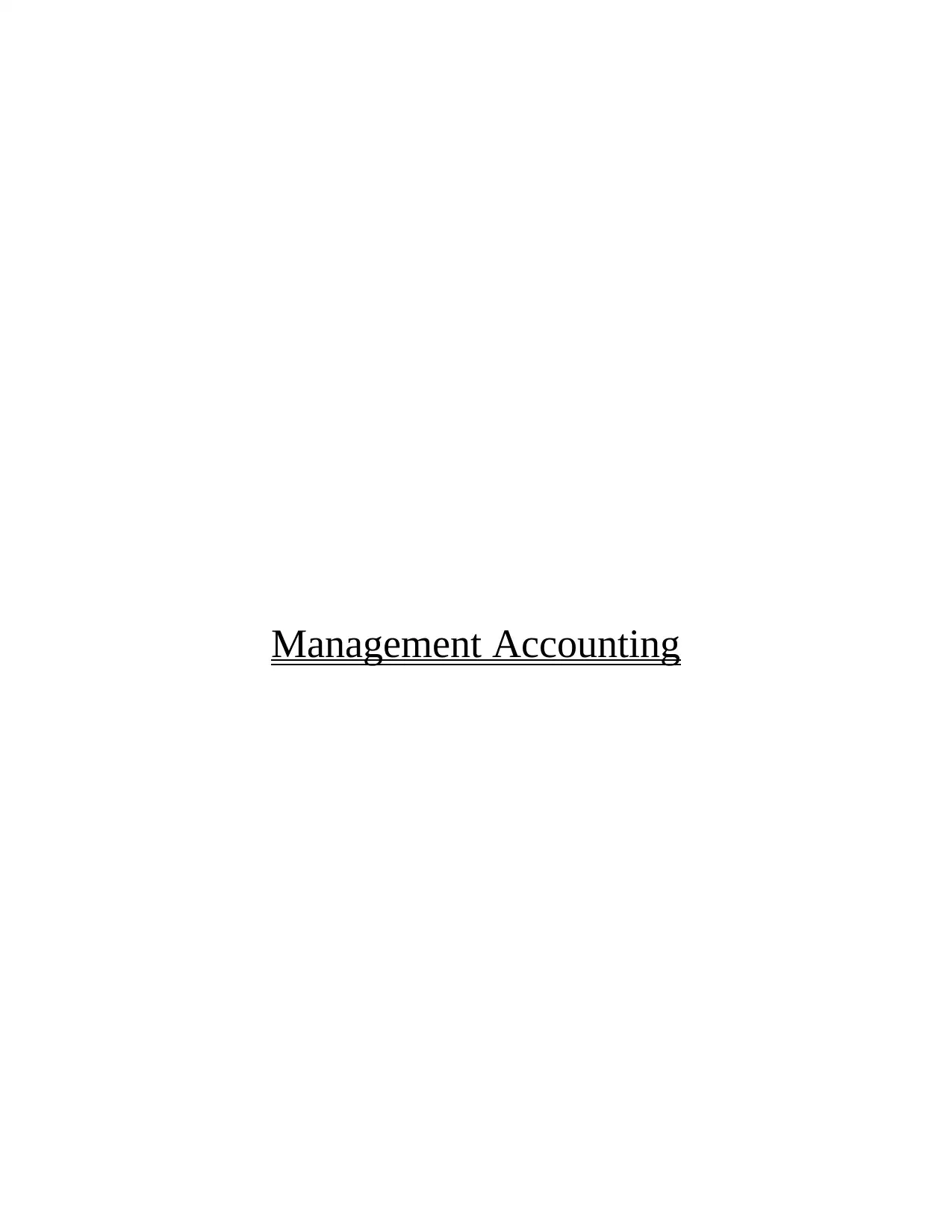
Management Accounting
Paraphrase This Document
Need a fresh take? Get an instant paraphrase of this document with our AI Paraphraser
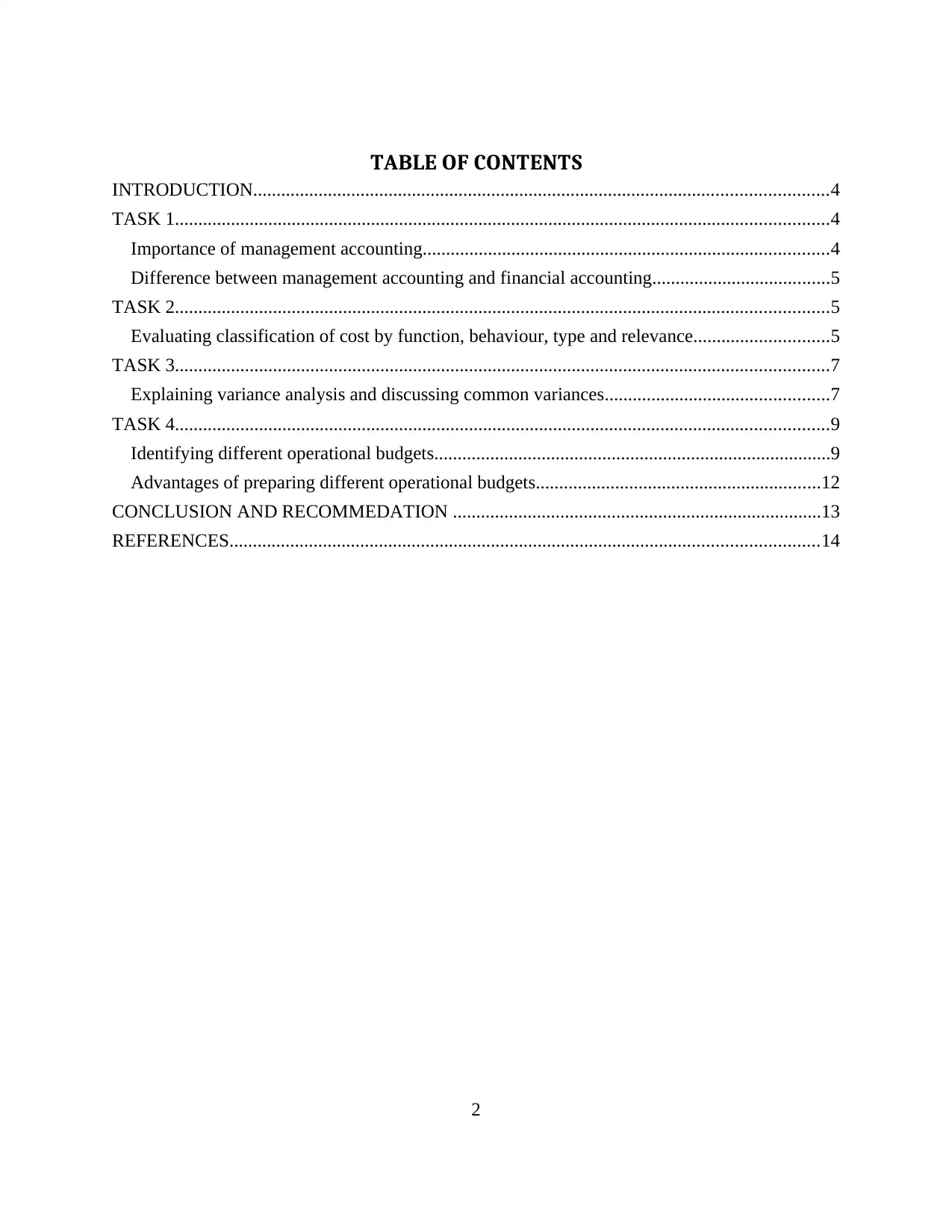
TABLE OF CONTENTS
INTRODUCTION...........................................................................................................................4
TASK 1............................................................................................................................................4
Importance of management accounting.......................................................................................4
Difference between management accounting and financial accounting......................................5
TASK 2............................................................................................................................................5
Evaluating classification of cost by function, behaviour, type and relevance.............................5
TASK 3............................................................................................................................................7
Explaining variance analysis and discussing common variances................................................7
TASK 4............................................................................................................................................9
Identifying different operational budgets.....................................................................................9
Advantages of preparing different operational budgets.............................................................12
CONCLUSION AND RECOMMEDATION ...............................................................................13
REFERENCES..............................................................................................................................14
2
INTRODUCTION...........................................................................................................................4
TASK 1............................................................................................................................................4
Importance of management accounting.......................................................................................4
Difference between management accounting and financial accounting......................................5
TASK 2............................................................................................................................................5
Evaluating classification of cost by function, behaviour, type and relevance.............................5
TASK 3............................................................................................................................................7
Explaining variance analysis and discussing common variances................................................7
TASK 4............................................................................................................................................9
Identifying different operational budgets.....................................................................................9
Advantages of preparing different operational budgets.............................................................12
CONCLUSION AND RECOMMEDATION ...............................................................................13
REFERENCES..............................................................................................................................14
2
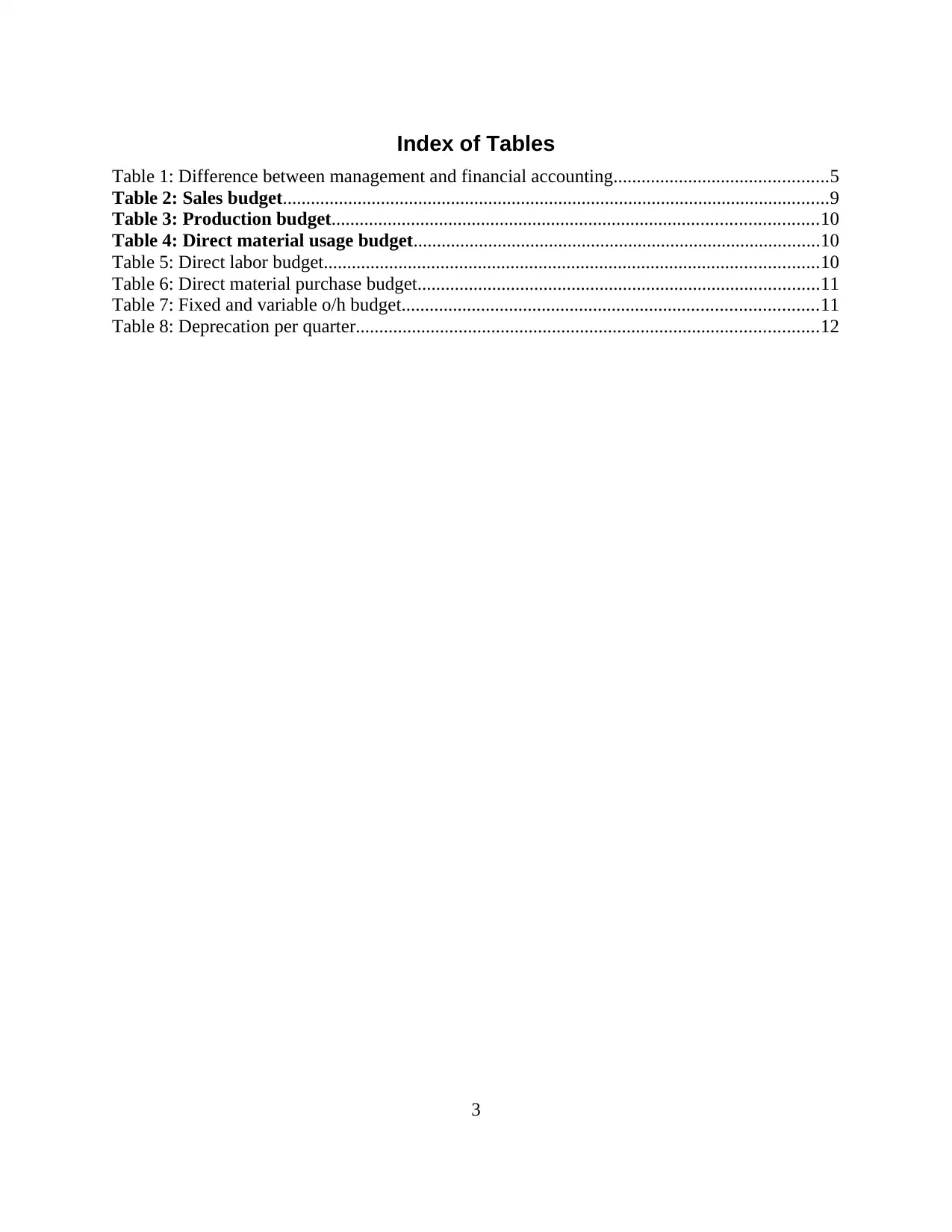
Index of Tables
Table 1: Difference between management and financial accounting..............................................5
Table 2: Sales budget.....................................................................................................................9
Table 3: Production budget........................................................................................................10
Table 4: Direct material usage budget.......................................................................................10
Table 5: Direct labor budget..........................................................................................................10
Table 6: Direct material purchase budget......................................................................................11
Table 7: Fixed and variable o/h budget.........................................................................................11
Table 8: Deprecation per quarter...................................................................................................12
3
Table 1: Difference between management and financial accounting..............................................5
Table 2: Sales budget.....................................................................................................................9
Table 3: Production budget........................................................................................................10
Table 4: Direct material usage budget.......................................................................................10
Table 5: Direct labor budget..........................................................................................................10
Table 6: Direct material purchase budget......................................................................................11
Table 7: Fixed and variable o/h budget.........................................................................................11
Table 8: Deprecation per quarter...................................................................................................12
3
⊘ This is a preview!⊘
Do you want full access?
Subscribe today to unlock all pages.

Trusted by 1+ million students worldwide
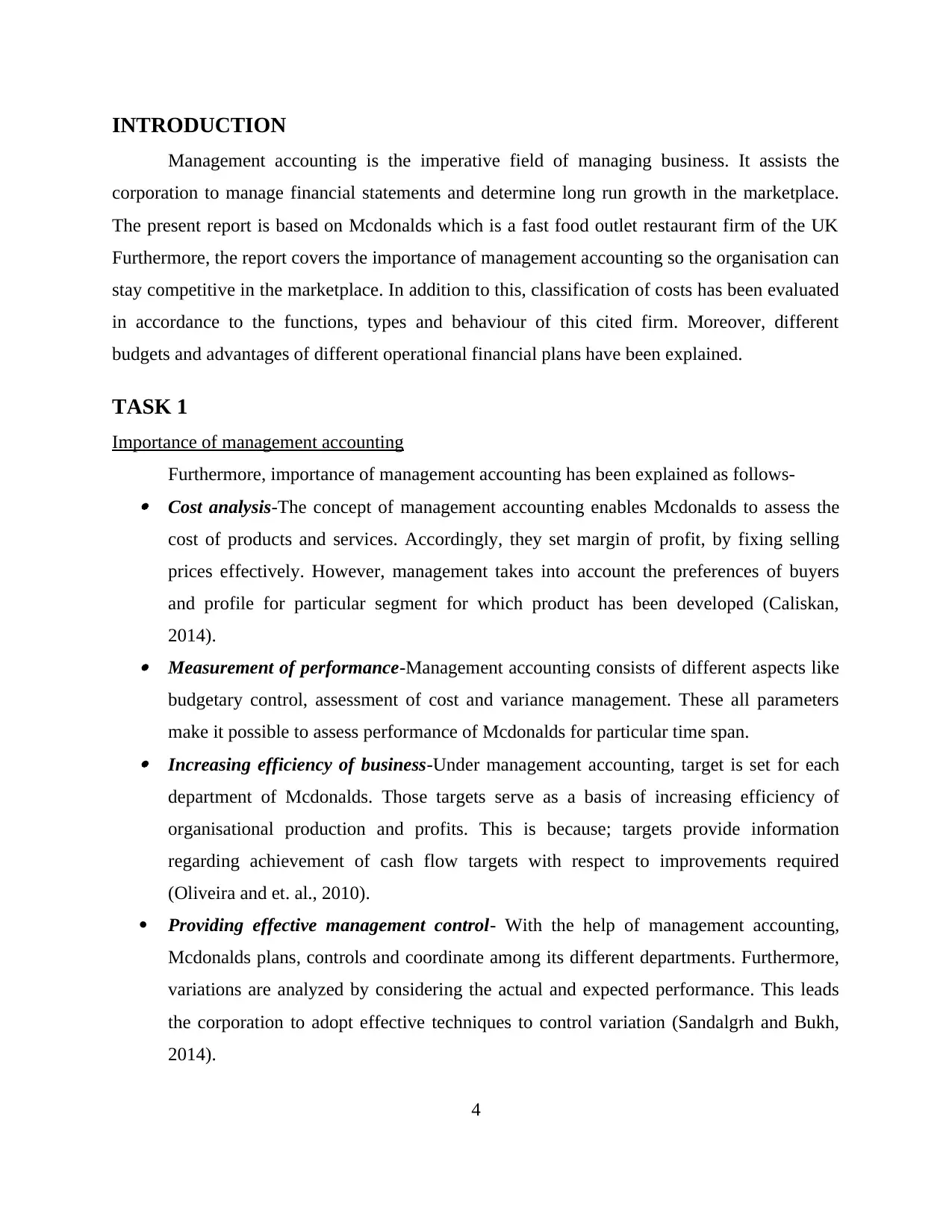
INTRODUCTION
Management accounting is the imperative field of managing business. It assists the
corporation to manage financial statements and determine long run growth in the marketplace.
The present report is based on Mcdonalds which is a fast food outlet restaurant firm of the UK
Furthermore, the report covers the importance of management accounting so the organisation can
stay competitive in the marketplace. In addition to this, classification of costs has been evaluated
in accordance to the functions, types and behaviour of this cited firm. Moreover, different
budgets and advantages of different operational financial plans have been explained.
TASK 1
Importance of management accounting
Furthermore, importance of management accounting has been explained as follows- Cost analysis-The concept of management accounting enables Mcdonalds to assess the
cost of products and services. Accordingly, they set margin of profit, by fixing selling
prices effectively. However, management takes into account the preferences of buyers
and profile for particular segment for which product has been developed (Caliskan,
2014). Measurement of performance-Management accounting consists of different aspects like
budgetary control, assessment of cost and variance management. These all parameters
make it possible to assess performance of Mcdonalds for particular time span. Increasing efficiency of business-Under management accounting, target is set for each
department of Mcdonalds. Those targets serve as a basis of increasing efficiency of
organisational production and profits. This is because; targets provide information
regarding achievement of cash flow targets with respect to improvements required
(Oliveira and et. al., 2010).
Providing effective management control- With the help of management accounting,
Mcdonalds plans, controls and coordinate among its different departments. Furthermore,
variations are analyzed by considering the actual and expected performance. This leads
the corporation to adopt effective techniques to control variation (Sandalgrh and Bukh,
2014).
4
Management accounting is the imperative field of managing business. It assists the
corporation to manage financial statements and determine long run growth in the marketplace.
The present report is based on Mcdonalds which is a fast food outlet restaurant firm of the UK
Furthermore, the report covers the importance of management accounting so the organisation can
stay competitive in the marketplace. In addition to this, classification of costs has been evaluated
in accordance to the functions, types and behaviour of this cited firm. Moreover, different
budgets and advantages of different operational financial plans have been explained.
TASK 1
Importance of management accounting
Furthermore, importance of management accounting has been explained as follows- Cost analysis-The concept of management accounting enables Mcdonalds to assess the
cost of products and services. Accordingly, they set margin of profit, by fixing selling
prices effectively. However, management takes into account the preferences of buyers
and profile for particular segment for which product has been developed (Caliskan,
2014). Measurement of performance-Management accounting consists of different aspects like
budgetary control, assessment of cost and variance management. These all parameters
make it possible to assess performance of Mcdonalds for particular time span. Increasing efficiency of business-Under management accounting, target is set for each
department of Mcdonalds. Those targets serve as a basis of increasing efficiency of
organisational production and profits. This is because; targets provide information
regarding achievement of cash flow targets with respect to improvements required
(Oliveira and et. al., 2010).
Providing effective management control- With the help of management accounting,
Mcdonalds plans, controls and coordinate among its different departments. Furthermore,
variations are analyzed by considering the actual and expected performance. This leads
the corporation to adopt effective techniques to control variation (Sandalgrh and Bukh,
2014).
4
Paraphrase This Document
Need a fresh take? Get an instant paraphrase of this document with our AI Paraphraser
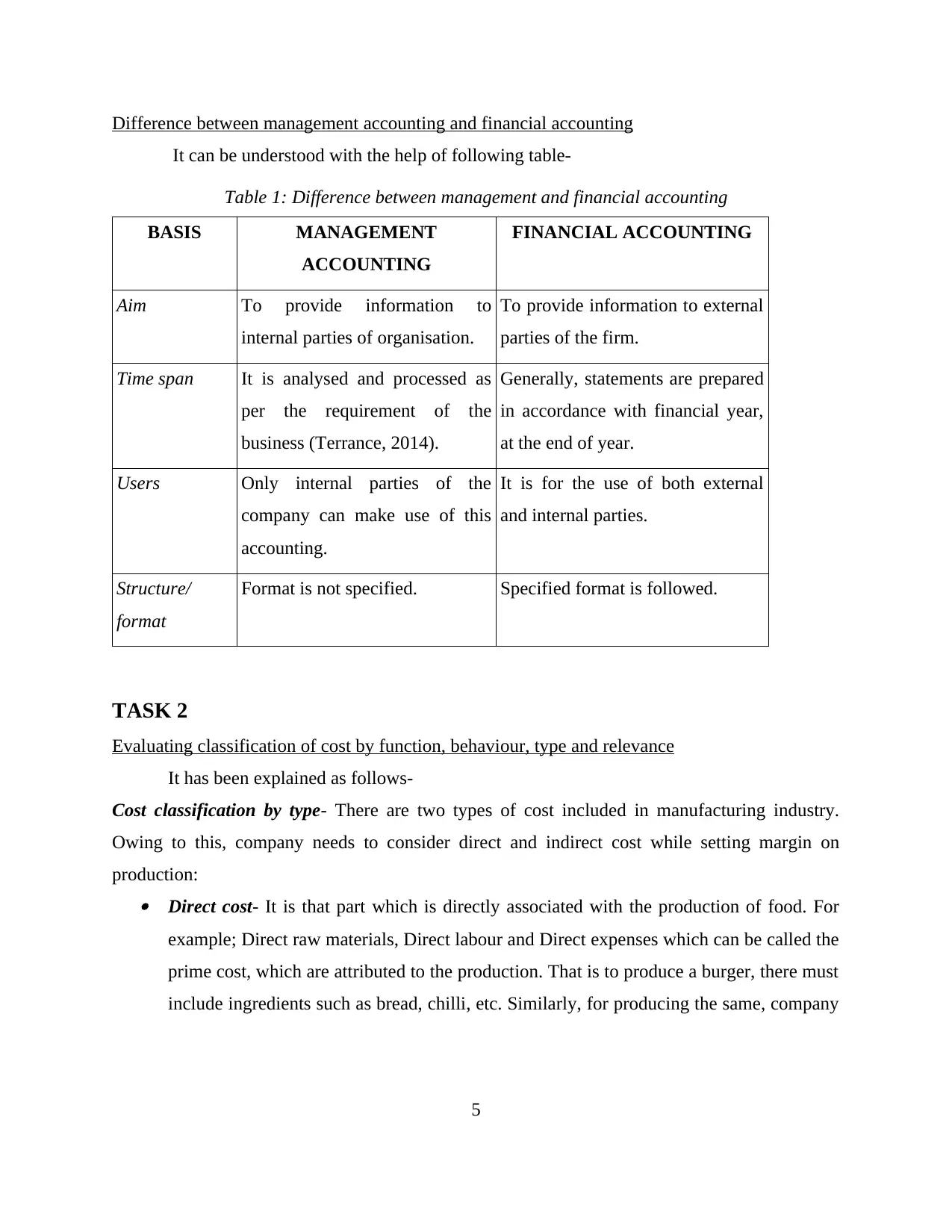
Difference between management accounting and financial accounting
It can be understood with the help of following table-
Table 1: Difference between management and financial accounting
BASIS MANAGEMENT
ACCOUNTING
FINANCIAL ACCOUNTING
Aim To provide information to
internal parties of organisation.
To provide information to external
parties of the firm.
Time span It is analysed and processed as
per the requirement of the
business (Terrance, 2014).
Generally, statements are prepared
in accordance with financial year,
at the end of year.
Users Only internal parties of the
company can make use of this
accounting.
It is for the use of both external
and internal parties.
Structure/
format
Format is not specified. Specified format is followed.
TASK 2
Evaluating classification of cost by function, behaviour, type and relevance
It has been explained as follows-
Cost classification by type- There are two types of cost included in manufacturing industry.
Owing to this, company needs to consider direct and indirect cost while setting margin on
production: Direct cost- It is that part which is directly associated with the production of food. For
example; Direct raw materials, Direct labour and Direct expenses which can be called the
prime cost, which are attributed to the production. That is to produce a burger, there must
include ingredients such as bread, chilli, etc. Similarly, for producing the same, company
5
It can be understood with the help of following table-
Table 1: Difference between management and financial accounting
BASIS MANAGEMENT
ACCOUNTING
FINANCIAL ACCOUNTING
Aim To provide information to
internal parties of organisation.
To provide information to external
parties of the firm.
Time span It is analysed and processed as
per the requirement of the
business (Terrance, 2014).
Generally, statements are prepared
in accordance with financial year,
at the end of year.
Users Only internal parties of the
company can make use of this
accounting.
It is for the use of both external
and internal parties.
Structure/
format
Format is not specified. Specified format is followed.
TASK 2
Evaluating classification of cost by function, behaviour, type and relevance
It has been explained as follows-
Cost classification by type- There are two types of cost included in manufacturing industry.
Owing to this, company needs to consider direct and indirect cost while setting margin on
production: Direct cost- It is that part which is directly associated with the production of food. For
example; Direct raw materials, Direct labour and Direct expenses which can be called the
prime cost, which are attributed to the production. That is to produce a burger, there must
include ingredients such as bread, chilli, etc. Similarly, for producing the same, company
5
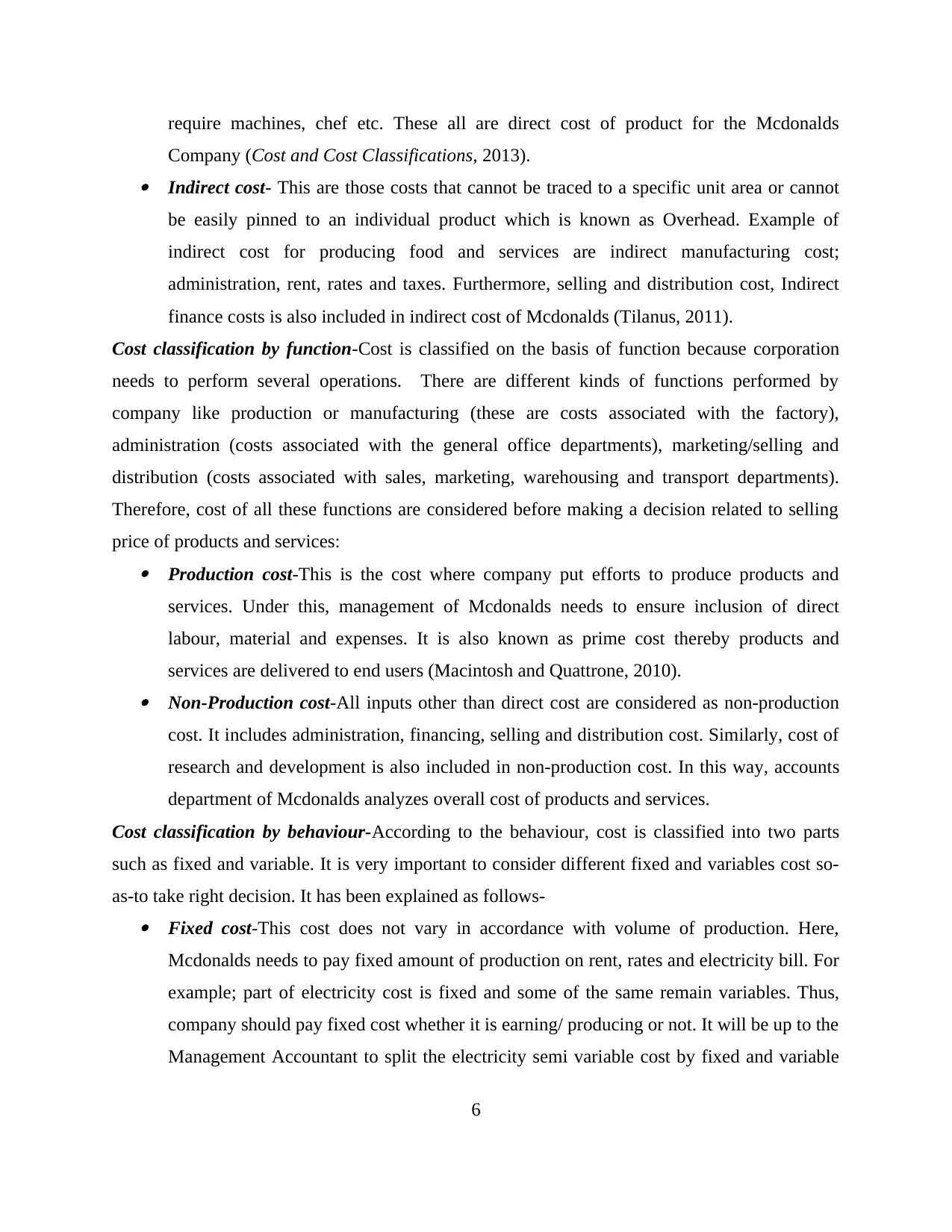
require machines, chef etc. These all are direct cost of product for the Mcdonalds
Company (Cost and Cost Classifications, 2013). Indirect cost- This are those costs that cannot be traced to a specific unit area or cannot
be easily pinned to an individual product which is known as Overhead. Example of
indirect cost for producing food and services are indirect manufacturing cost;
administration, rent, rates and taxes. Furthermore, selling and distribution cost, Indirect
finance costs is also included in indirect cost of Mcdonalds (Tilanus, 2011).
Cost classification by function-Cost is classified on the basis of function because corporation
needs to perform several operations. There are different kinds of functions performed by
company like production or manufacturing (these are costs associated with the factory),
administration (costs associated with the general office departments), marketing/selling and
distribution (costs associated with sales, marketing, warehousing and transport departments).
Therefore, cost of all these functions are considered before making a decision related to selling
price of products and services: Production cost-This is the cost where company put efforts to produce products and
services. Under this, management of Mcdonalds needs to ensure inclusion of direct
labour, material and expenses. It is also known as prime cost thereby products and
services are delivered to end users (Macintosh and Quattrone, 2010). Non-Production cost-All inputs other than direct cost are considered as non-production
cost. It includes administration, financing, selling and distribution cost. Similarly, cost of
research and development is also included in non-production cost. In this way, accounts
department of Mcdonalds analyzes overall cost of products and services.
Cost classification by behaviour-According to the behaviour, cost is classified into two parts
such as fixed and variable. It is very important to consider different fixed and variables cost so-
as-to take right decision. It has been explained as follows- Fixed cost-This cost does not vary in accordance with volume of production. Here,
Mcdonalds needs to pay fixed amount of production on rent, rates and electricity bill. For
example; part of electricity cost is fixed and some of the same remain variables. Thus,
company should pay fixed cost whether it is earning/ producing or not. It will be up to the
Management Accountant to split the electricity semi variable cost by fixed and variable
6
Company (Cost and Cost Classifications, 2013). Indirect cost- This are those costs that cannot be traced to a specific unit area or cannot
be easily pinned to an individual product which is known as Overhead. Example of
indirect cost for producing food and services are indirect manufacturing cost;
administration, rent, rates and taxes. Furthermore, selling and distribution cost, Indirect
finance costs is also included in indirect cost of Mcdonalds (Tilanus, 2011).
Cost classification by function-Cost is classified on the basis of function because corporation
needs to perform several operations. There are different kinds of functions performed by
company like production or manufacturing (these are costs associated with the factory),
administration (costs associated with the general office departments), marketing/selling and
distribution (costs associated with sales, marketing, warehousing and transport departments).
Therefore, cost of all these functions are considered before making a decision related to selling
price of products and services: Production cost-This is the cost where company put efforts to produce products and
services. Under this, management of Mcdonalds needs to ensure inclusion of direct
labour, material and expenses. It is also known as prime cost thereby products and
services are delivered to end users (Macintosh and Quattrone, 2010). Non-Production cost-All inputs other than direct cost are considered as non-production
cost. It includes administration, financing, selling and distribution cost. Similarly, cost of
research and development is also included in non-production cost. In this way, accounts
department of Mcdonalds analyzes overall cost of products and services.
Cost classification by behaviour-According to the behaviour, cost is classified into two parts
such as fixed and variable. It is very important to consider different fixed and variables cost so-
as-to take right decision. It has been explained as follows- Fixed cost-This cost does not vary in accordance with volume of production. Here,
Mcdonalds needs to pay fixed amount of production on rent, rates and electricity bill. For
example; part of electricity cost is fixed and some of the same remain variables. Thus,
company should pay fixed cost whether it is earning/ producing or not. It will be up to the
Management Accountant to split the electricity semi variable cost by fixed and variable
6
⊘ This is a preview!⊘
Do you want full access?
Subscribe today to unlock all pages.

Trusted by 1+ million students worldwide
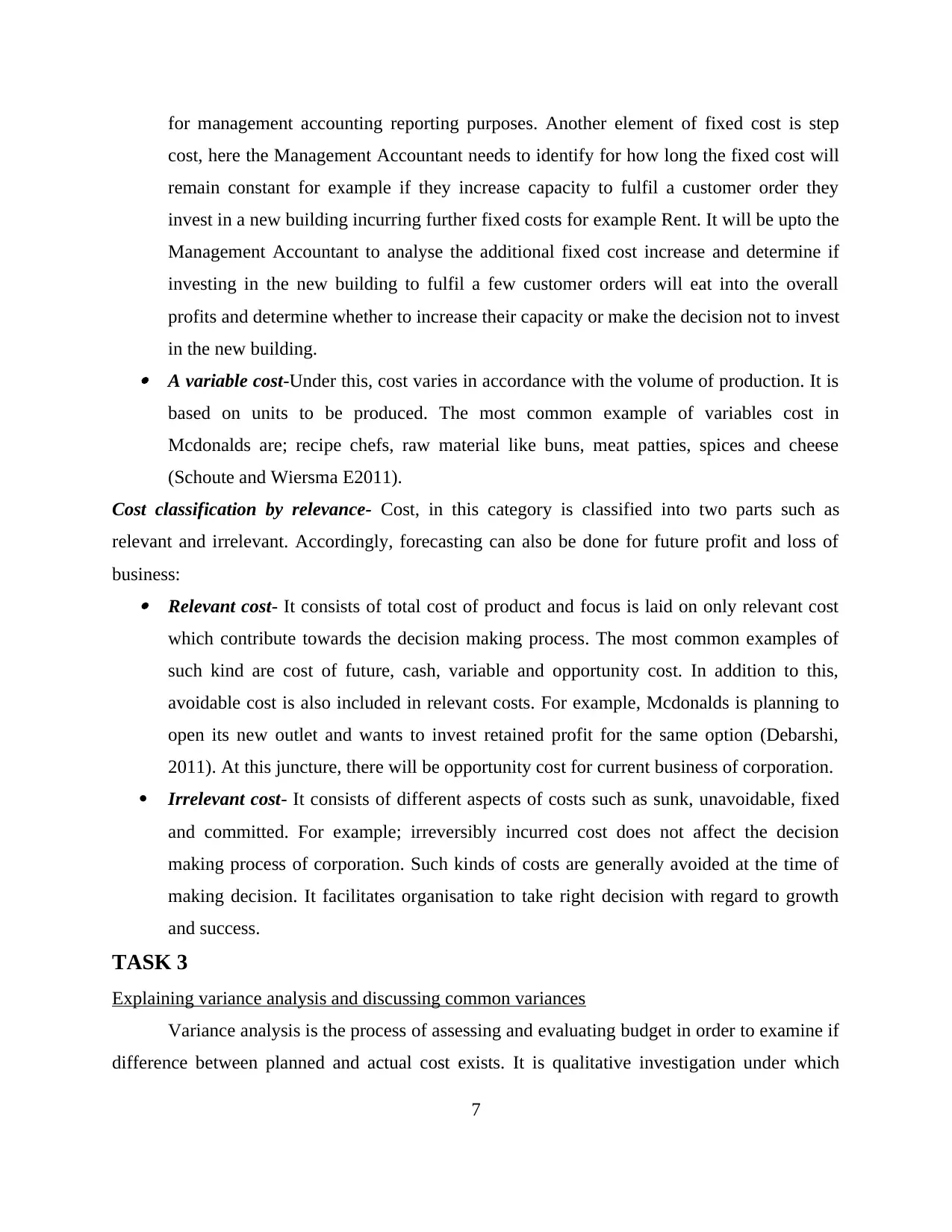
for management accounting reporting purposes. Another element of fixed cost is step
cost, here the Management Accountant needs to identify for how long the fixed cost will
remain constant for example if they increase capacity to fulfil a customer order they
invest in a new building incurring further fixed costs for example Rent. It will be upto the
Management Accountant to analyse the additional fixed cost increase and determine if
investing in the new building to fulfil a few customer orders will eat into the overall
profits and determine whether to increase their capacity or make the decision not to invest
in the new building. A variable cost-Under this, cost varies in accordance with the volume of production. It is
based on units to be produced. The most common example of variables cost in
Mcdonalds are; recipe chefs, raw material like buns, meat patties, spices and cheese
(Schoute and Wiersma E2011).
Cost classification by relevance- Cost, in this category is classified into two parts such as
relevant and irrelevant. Accordingly, forecasting can also be done for future profit and loss of
business: Relevant cost- It consists of total cost of product and focus is laid on only relevant cost
which contribute towards the decision making process. The most common examples of
such kind are cost of future, cash, variable and opportunity cost. In addition to this,
avoidable cost is also included in relevant costs. For example, Mcdonalds is planning to
open its new outlet and wants to invest retained profit for the same option (Debarshi,
2011). At this juncture, there will be opportunity cost for current business of corporation.
Irrelevant cost- It consists of different aspects of costs such as sunk, unavoidable, fixed
and committed. For example; irreversibly incurred cost does not affect the decision
making process of corporation. Such kinds of costs are generally avoided at the time of
making decision. It facilitates organisation to take right decision with regard to growth
and success.
TASK 3
Explaining variance analysis and discussing common variances
Variance analysis is the process of assessing and evaluating budget in order to examine if
difference between planned and actual cost exists. It is qualitative investigation under which
7
cost, here the Management Accountant needs to identify for how long the fixed cost will
remain constant for example if they increase capacity to fulfil a customer order they
invest in a new building incurring further fixed costs for example Rent. It will be upto the
Management Accountant to analyse the additional fixed cost increase and determine if
investing in the new building to fulfil a few customer orders will eat into the overall
profits and determine whether to increase their capacity or make the decision not to invest
in the new building. A variable cost-Under this, cost varies in accordance with the volume of production. It is
based on units to be produced. The most common example of variables cost in
Mcdonalds are; recipe chefs, raw material like buns, meat patties, spices and cheese
(Schoute and Wiersma E2011).
Cost classification by relevance- Cost, in this category is classified into two parts such as
relevant and irrelevant. Accordingly, forecasting can also be done for future profit and loss of
business: Relevant cost- It consists of total cost of product and focus is laid on only relevant cost
which contribute towards the decision making process. The most common examples of
such kind are cost of future, cash, variable and opportunity cost. In addition to this,
avoidable cost is also included in relevant costs. For example, Mcdonalds is planning to
open its new outlet and wants to invest retained profit for the same option (Debarshi,
2011). At this juncture, there will be opportunity cost for current business of corporation.
Irrelevant cost- It consists of different aspects of costs such as sunk, unavoidable, fixed
and committed. For example; irreversibly incurred cost does not affect the decision
making process of corporation. Such kinds of costs are generally avoided at the time of
making decision. It facilitates organisation to take right decision with regard to growth
and success.
TASK 3
Explaining variance analysis and discussing common variances
Variance analysis is the process of assessing and evaluating budget in order to examine if
difference between planned and actual cost exists. It is qualitative investigation under which
7
Paraphrase This Document
Need a fresh take? Get an instant paraphrase of this document with our AI Paraphraser
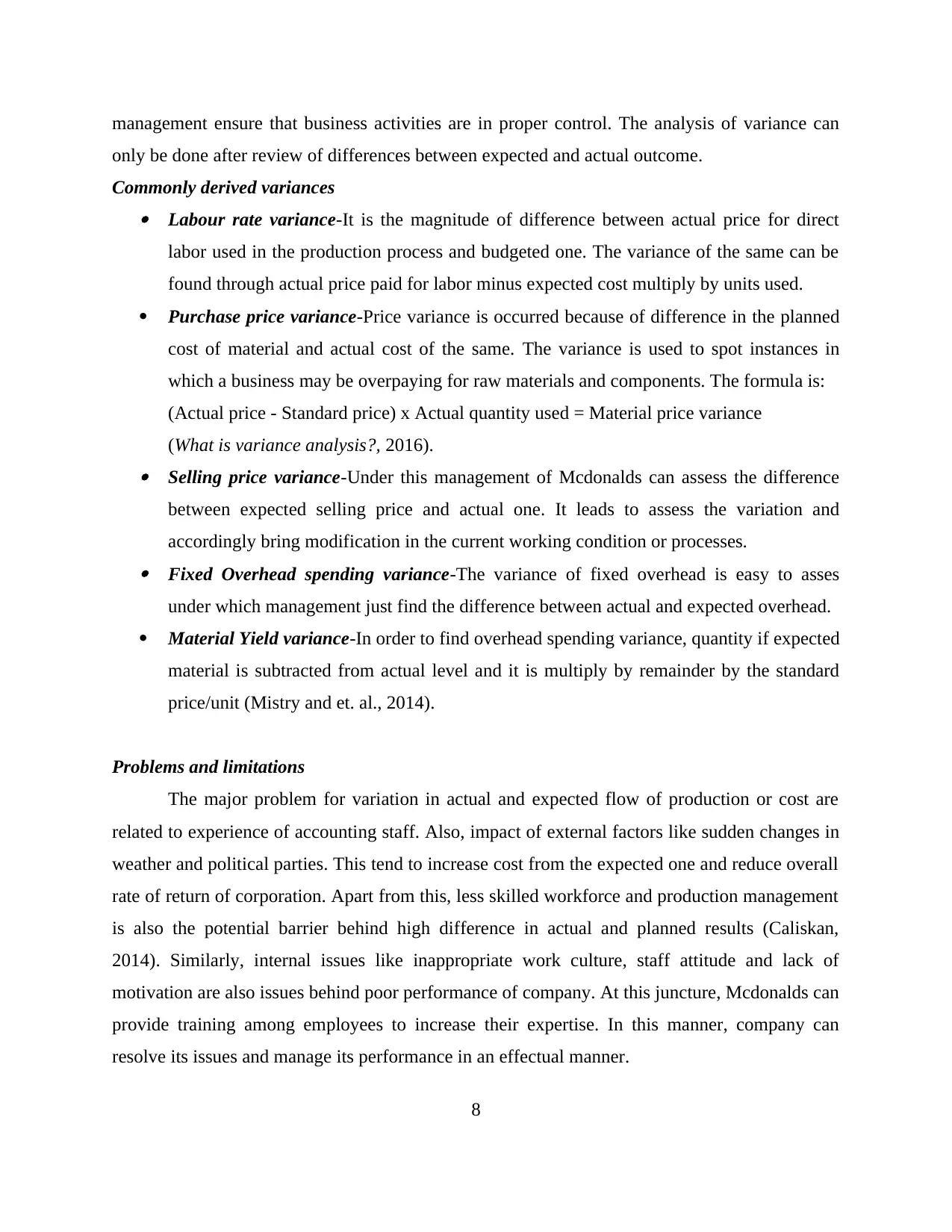
management ensure that business activities are in proper control. The analysis of variance can
only be done after review of differences between expected and actual outcome.
Commonly derived variances Labour rate variance-It is the magnitude of difference between actual price for direct
labor used in the production process and budgeted one. The variance of the same can be
found through actual price paid for labor minus expected cost multiply by units used.
Purchase price variance-Price variance is occurred because of difference in the planned
cost of material and actual cost of the same. The variance is used to spot instances in
which a business may be overpaying for raw materials and components. The formula is:
(Actual price - Standard price) x Actual quantity used = Material price variance
(What is variance analysis?, 2016). Selling price variance-Under this management of Mcdonalds can assess the difference
between expected selling price and actual one. It leads to assess the variation and
accordingly bring modification in the current working condition or processes. Fixed Overhead spending variance-The variance of fixed overhead is easy to asses
under which management just find the difference between actual and expected overhead.
Material Yield variance-In order to find overhead spending variance, quantity if expected
material is subtracted from actual level and it is multiply by remainder by the standard
price/unit (Mistry and et. al., 2014).
Problems and limitations
The major problem for variation in actual and expected flow of production or cost are
related to experience of accounting staff. Also, impact of external factors like sudden changes in
weather and political parties. This tend to increase cost from the expected one and reduce overall
rate of return of corporation. Apart from this, less skilled workforce and production management
is also the potential barrier behind high difference in actual and planned results (Caliskan,
2014). Similarly, internal issues like inappropriate work culture, staff attitude and lack of
motivation are also issues behind poor performance of company. At this juncture, Mcdonalds can
provide training among employees to increase their expertise. In this manner, company can
resolve its issues and manage its performance in an effectual manner.
8
only be done after review of differences between expected and actual outcome.
Commonly derived variances Labour rate variance-It is the magnitude of difference between actual price for direct
labor used in the production process and budgeted one. The variance of the same can be
found through actual price paid for labor minus expected cost multiply by units used.
Purchase price variance-Price variance is occurred because of difference in the planned
cost of material and actual cost of the same. The variance is used to spot instances in
which a business may be overpaying for raw materials and components. The formula is:
(Actual price - Standard price) x Actual quantity used = Material price variance
(What is variance analysis?, 2016). Selling price variance-Under this management of Mcdonalds can assess the difference
between expected selling price and actual one. It leads to assess the variation and
accordingly bring modification in the current working condition or processes. Fixed Overhead spending variance-The variance of fixed overhead is easy to asses
under which management just find the difference between actual and expected overhead.
Material Yield variance-In order to find overhead spending variance, quantity if expected
material is subtracted from actual level and it is multiply by remainder by the standard
price/unit (Mistry and et. al., 2014).
Problems and limitations
The major problem for variation in actual and expected flow of production or cost are
related to experience of accounting staff. Also, impact of external factors like sudden changes in
weather and political parties. This tend to increase cost from the expected one and reduce overall
rate of return of corporation. Apart from this, less skilled workforce and production management
is also the potential barrier behind high difference in actual and planned results (Caliskan,
2014). Similarly, internal issues like inappropriate work culture, staff attitude and lack of
motivation are also issues behind poor performance of company. At this juncture, Mcdonalds can
provide training among employees to increase their expertise. In this manner, company can
resolve its issues and manage its performance in an effectual manner.
8

TASK 4
Identifying different operational budgets
There are different operation budget used in Mcdonalds which are presented as follows-
1. Sales budget
This is what the management expects to sell and the revenues collected from these sales.
(ACCA, 2015)
Table 2: Sales budget Illustration of theory in practice
2. Closing stock of finished goods budget- A business’s remaining stock at the end of an
accounting period. Ending Inventory = Opening Stock + Purchases during the year – Cost of
Goods sold.
3. Production budget
The production budget is the calculation of the number of units of products that must be
manufactured from a combination of the sales forecast and the planned amount of finished goods
inventory (Bhimani, Horngren, Datar, & Rajan, 2015), as illustrated in the table below.
Table 3: Production budget
4. Direct material usage budget
9
Identifying different operational budgets
There are different operation budget used in Mcdonalds which are presented as follows-
1. Sales budget
This is what the management expects to sell and the revenues collected from these sales.
(ACCA, 2015)
Table 2: Sales budget Illustration of theory in practice
2. Closing stock of finished goods budget- A business’s remaining stock at the end of an
accounting period. Ending Inventory = Opening Stock + Purchases during the year – Cost of
Goods sold.
3. Production budget
The production budget is the calculation of the number of units of products that must be
manufactured from a combination of the sales forecast and the planned amount of finished goods
inventory (Bhimani, Horngren, Datar, & Rajan, 2015), as illustrated in the table below.
Table 3: Production budget
4. Direct material usage budget
9
⊘ This is a preview!⊘
Do you want full access?
Subscribe today to unlock all pages.

Trusted by 1+ million students worldwide
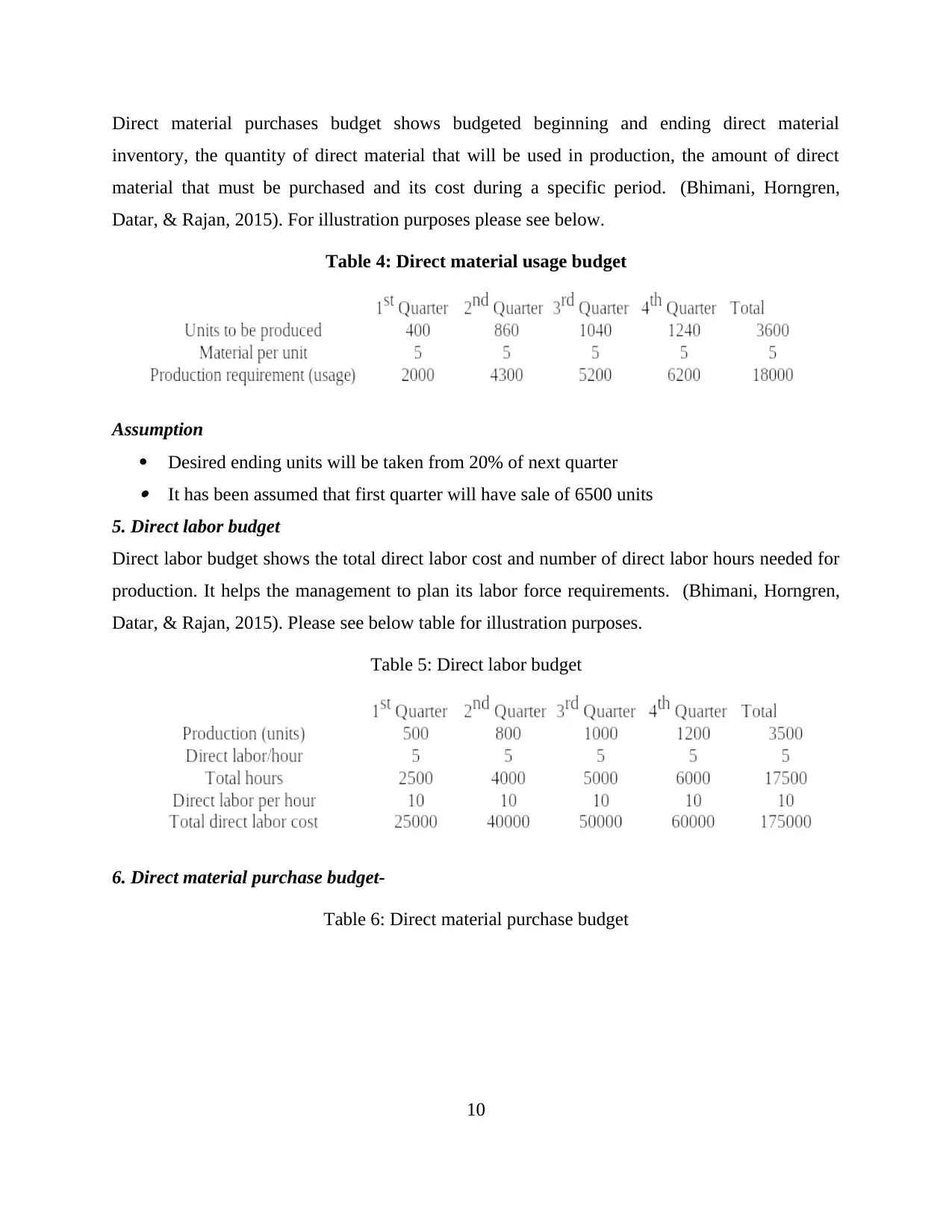
Direct material purchases budget shows budgeted beginning and ending direct material
inventory, the quantity of direct material that will be used in production, the amount of direct
material that must be purchased and its cost during a specific period. (Bhimani, Horngren,
Datar, & Rajan, 2015). For illustration purposes please see below.
Table 4: Direct material usage budget
Assumption
Desired ending units will be taken from 20% of next quarter It has been assumed that first quarter will have sale of 6500 units
5. Direct labor budget
Direct labor budget shows the total direct labor cost and number of direct labor hours needed for
production. It helps the management to plan its labor force requirements. (Bhimani, Horngren,
Datar, & Rajan, 2015). Please see below table for illustration purposes.
Table 5: Direct labor budget
6. Direct material purchase budget-
Table 6: Direct material purchase budget
10
inventory, the quantity of direct material that will be used in production, the amount of direct
material that must be purchased and its cost during a specific period. (Bhimani, Horngren,
Datar, & Rajan, 2015). For illustration purposes please see below.
Table 4: Direct material usage budget
Assumption
Desired ending units will be taken from 20% of next quarter It has been assumed that first quarter will have sale of 6500 units
5. Direct labor budget
Direct labor budget shows the total direct labor cost and number of direct labor hours needed for
production. It helps the management to plan its labor force requirements. (Bhimani, Horngren,
Datar, & Rajan, 2015). Please see below table for illustration purposes.
Table 5: Direct labor budget
6. Direct material purchase budget-
Table 6: Direct material purchase budget
10
Paraphrase This Document
Need a fresh take? Get an instant paraphrase of this document with our AI Paraphraser
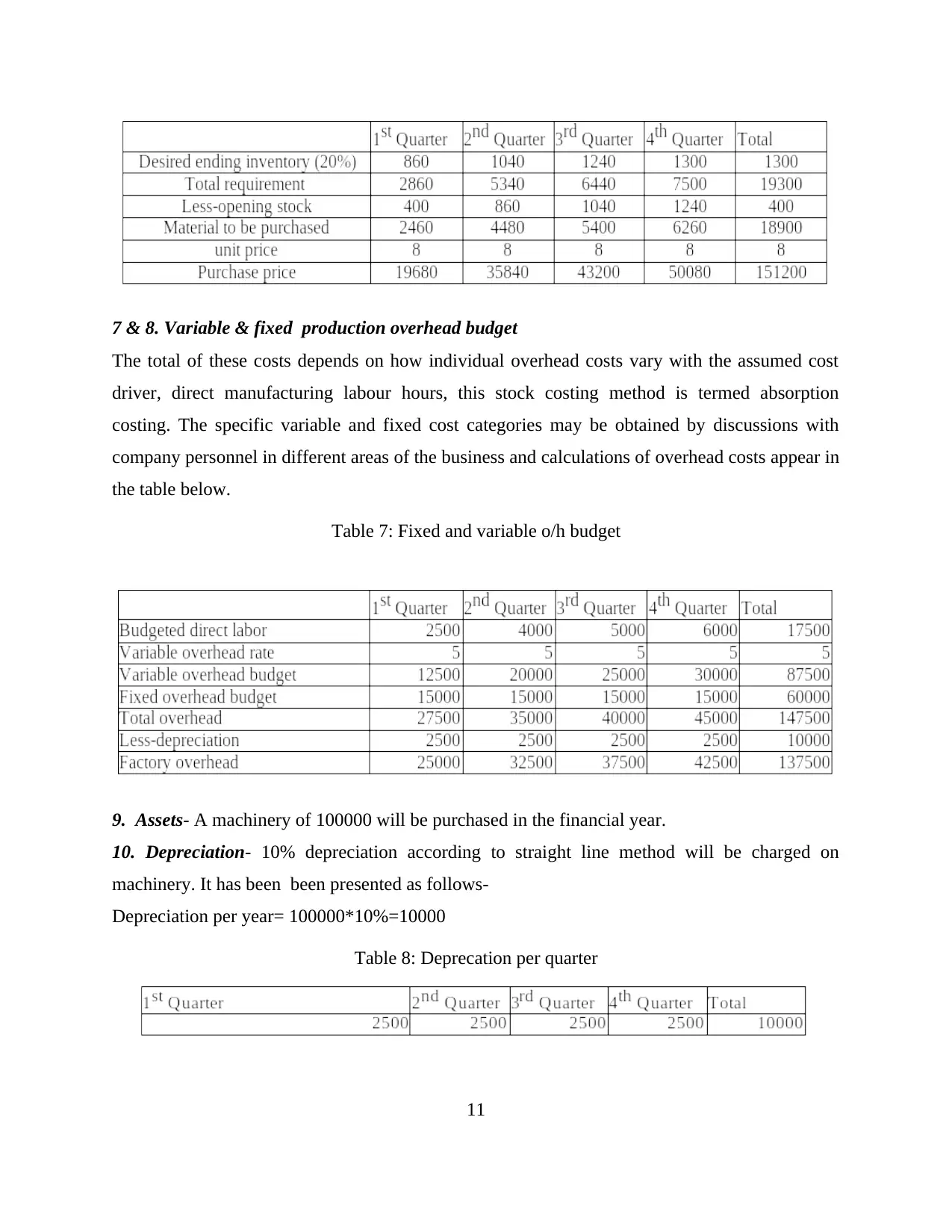
7 & 8. Variable & fixed production overhead budget
The total of these costs depends on how individual overhead costs vary with the assumed cost
driver, direct manufacturing labour hours, this stock costing method is termed absorption
costing. The specific variable and fixed cost categories may be obtained by discussions with
company personnel in different areas of the business and calculations of overhead costs appear in
the table below.
Table 7: Fixed and variable o/h budget
9. Assets- A machinery of 100000 will be purchased in the financial year.
10. Depreciation- 10% depreciation according to straight line method will be charged on
machinery. It has been been presented as follows-
Depreciation per year= 100000*10%=10000
Table 8: Deprecation per quarter
11
The total of these costs depends on how individual overhead costs vary with the assumed cost
driver, direct manufacturing labour hours, this stock costing method is termed absorption
costing. The specific variable and fixed cost categories may be obtained by discussions with
company personnel in different areas of the business and calculations of overhead costs appear in
the table below.
Table 7: Fixed and variable o/h budget
9. Assets- A machinery of 100000 will be purchased in the financial year.
10. Depreciation- 10% depreciation according to straight line method will be charged on
machinery. It has been been presented as follows-
Depreciation per year= 100000*10%=10000
Table 8: Deprecation per quarter
11
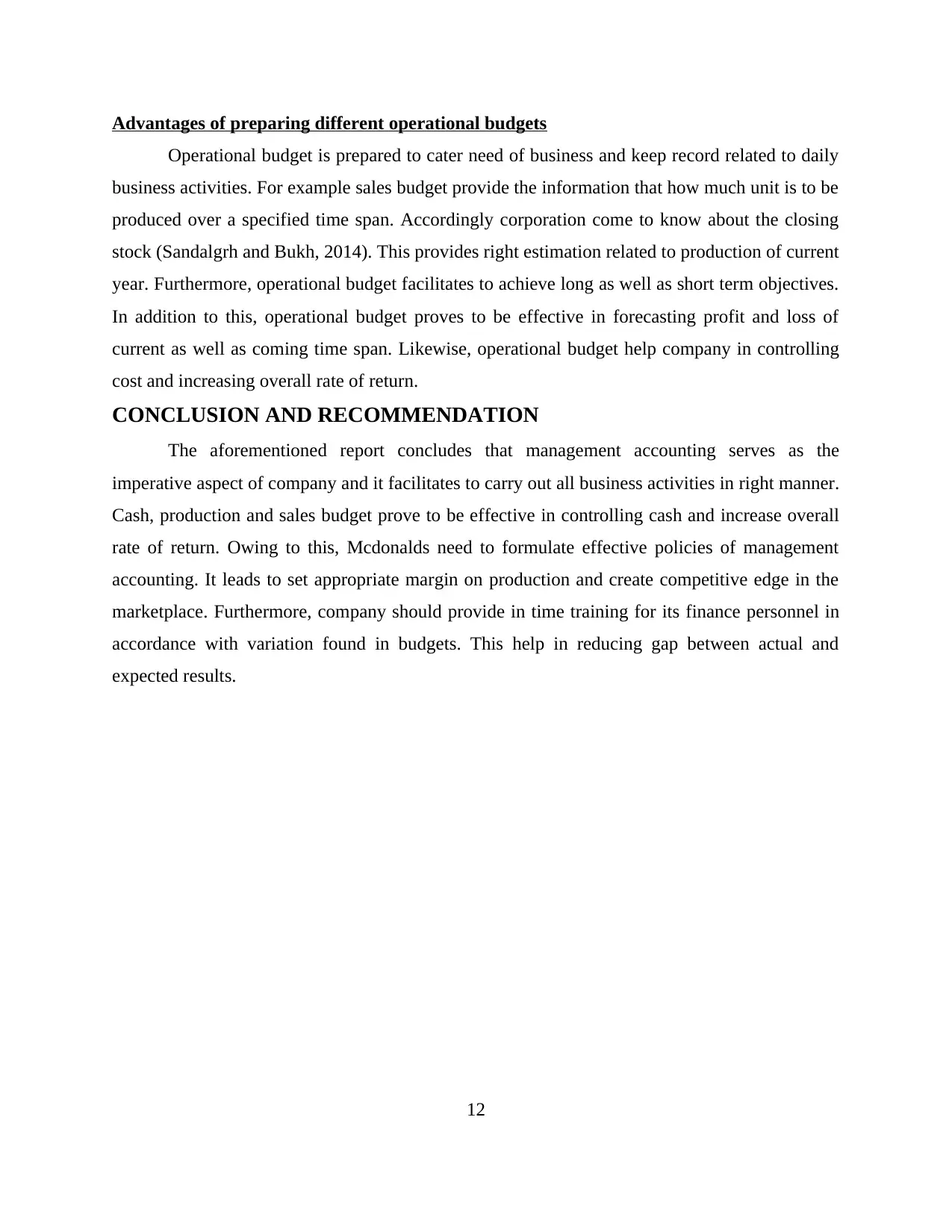
Advantages of preparing different operational budgets
Operational budget is prepared to cater need of business and keep record related to daily
business activities. For example sales budget provide the information that how much unit is to be
produced over a specified time span. Accordingly corporation come to know about the closing
stock (Sandalgrh and Bukh, 2014). This provides right estimation related to production of current
year. Furthermore, operational budget facilitates to achieve long as well as short term objectives.
In addition to this, operational budget proves to be effective in forecasting profit and loss of
current as well as coming time span. Likewise, operational budget help company in controlling
cost and increasing overall rate of return.
CONCLUSION AND RECOMMENDATION
The aforementioned report concludes that management accounting serves as the
imperative aspect of company and it facilitates to carry out all business activities in right manner.
Cash, production and sales budget prove to be effective in controlling cash and increase overall
rate of return. Owing to this, Mcdonalds need to formulate effective policies of management
accounting. It leads to set appropriate margin on production and create competitive edge in the
marketplace. Furthermore, company should provide in time training for its finance personnel in
accordance with variation found in budgets. This help in reducing gap between actual and
expected results.
12
Operational budget is prepared to cater need of business and keep record related to daily
business activities. For example sales budget provide the information that how much unit is to be
produced over a specified time span. Accordingly corporation come to know about the closing
stock (Sandalgrh and Bukh, 2014). This provides right estimation related to production of current
year. Furthermore, operational budget facilitates to achieve long as well as short term objectives.
In addition to this, operational budget proves to be effective in forecasting profit and loss of
current as well as coming time span. Likewise, operational budget help company in controlling
cost and increasing overall rate of return.
CONCLUSION AND RECOMMENDATION
The aforementioned report concludes that management accounting serves as the
imperative aspect of company and it facilitates to carry out all business activities in right manner.
Cash, production and sales budget prove to be effective in controlling cash and increase overall
rate of return. Owing to this, Mcdonalds need to formulate effective policies of management
accounting. It leads to set appropriate margin on production and create competitive edge in the
marketplace. Furthermore, company should provide in time training for its finance personnel in
accordance with variation found in budgets. This help in reducing gap between actual and
expected results.
12
⊘ This is a preview!⊘
Do you want full access?
Subscribe today to unlock all pages.

Trusted by 1+ million students worldwide
1 out of 14
Related Documents
Your All-in-One AI-Powered Toolkit for Academic Success.
+13062052269
info@desklib.com
Available 24*7 on WhatsApp / Email
![[object Object]](/_next/static/media/star-bottom.7253800d.svg)
Unlock your academic potential
Copyright © 2020–2025 A2Z Services. All Rights Reserved. Developed and managed by ZUCOL.





